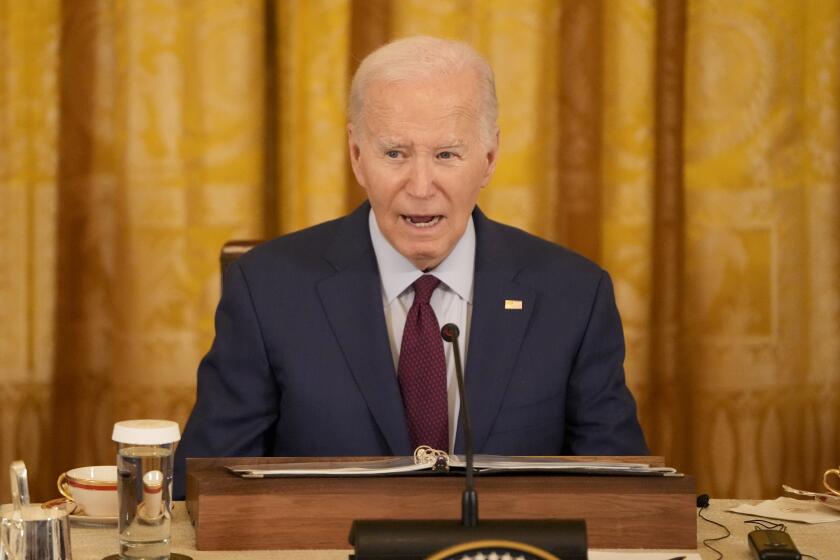A dash for classes
Norphesa Jones rises before dawn twice a week to take a 6 a.m. physical education class at Southwest College, just blocks from her home in South Los Angeles.
She then takes a bus to the Green Line, catches the train and another bus to Los Angeles Trade Tech downtown for an 8:30 a.m. math class. Jones then backtracks to Southwest for a personal development class that begins at 11:10 a.m.
Shuttling 20 miles between campuses isn’t by choice: The math class she needed wasn’t offered at Southwest.
“There have been times when I’ve sat in the room before class and cried, ready to quit because I don’t want to do this anymore,” said Jones, a 34-year-old wife and mother of three who hopes to become a nurse. “But then I think, why stop now because another way seems like it may be easier.”
She is part of a growing number of community college students statewide who have been forced to travel long distances by bus, car and train to get the classes they need after budget cuts resulted in course reductions systemwide.
Over two decades, the percentage of such students has more than doubled, from about 2.2% in 1992 to about 5.2% in 2011. Last fall, about 69,665 students attended two schools, nearly 5,000 went to three schools and about 400 to four or five schools, according to data from the California Community Colleges chancellor’s office. (The numbers include students who take online classes; officials are unsure how many are in that category.)
Most two-year colleges have also eliminated winter and summer sessions, further reducing the availability of classes students need to earn a degree or transfer to a four-year university. Some high-demand classes are offered only once during the academic year, leaving students with a stark choice: Wait and delay their education or shop around and find the course elsewhere.
Some college administrators say students taking classes at multiple campuses are displacing local students. Those officials are considering ways to curb the practice, such as giving local students priority enrollment for a period of time.
Colleges are in a tough spot, having to manage shrinking budgets while still providing the range of classes students need to obtain degrees or transfer.
“Schools want students to have sufficient courses, but ultimately students have to find their way through in one shape or form,” said Patrick C. Perry, the system’s vice chancellor of technology, research and information systems.
For Christina Atoyan, that means English class at Los Angeles Valley College in Valley Glen on Monday and Wednesdays. Biology at Valley on Mondays, Tuesday and Wednesdays. Statistics at Pierce College in Woodland Hills on Mondays and Wednesdays, plus an online speech class.
Later this month, she will begin a history class via video lectures offered by Mission College in Sylmar. The class includes a weekend session at one of four colleges.
The political science major wants to transfer to UCLA next fall. But she’s been stymied getting into all the classes she needs at one campus.
The drive from Valley to Pierce takes about a half-hour on the 101 Freeway, and more in traffic. The commute costs her valuable study time, which she tries to cram in on the weekends. Last summer she took classes at East Los Angeles College, more than an hour’s drive from her North Hollywood home.
She hears about the teacher layoffs and other effects of budget cuts in the Los Angeles Unified School District, where her mother works.
But she and just about all of her friends are feeling the pressures firsthand in California’s community college system, she said.
“I just want to transfer, to do what I want to do in life,” said Atoyan, 20. “Go to UCLA, get a degree, become politically active and then go to law school.”
Valley College geography professor Donald J. Gauthier estimates that about half of the students in his environmental studies class are enrolled at more than one campus. They sometimes come in late or need to leave early and ask that the time isn’t counted against their grade. He tries to fill time before the main lecture to accommodate them.
But Gauthier, who is president of the Academic Senate, said there are broader issues for the nine-campus Los Angeles Community College District, which is the largest in the nation.
Colleges prepare their class schedules independently and don’t know how many resources to devote to programs when students come from other campuses in the district.
Gauthier said it’s not fair to local students who can’t commute when someone with higher-priority registration from another campus takes their place in crowded classes.
Also, research by the district has found that students who commute to multiple campuses do worse academically than their peers who attend one college.
Officials are now proposing to allow colleges to give priority to local students for the first two weeks of the enrollment period before opening up classes to outside students.
“Students are more aware of the fact that sections are being cut and less is being offered; they are panicking and I totally understand that,” Gauthier said. “As faculty, we’re not here to stand in the way of students. But we are here to help our own campuses deal with the problem.”
Such restrictions, though, would deal a blow to students like Jin Ong, a Valley College student who takes African American history and biology at Valley, English at Pierce and Korean at City College in Hollywood.
Changing the rules would “definitely make it harder for me,” said Ong, 23. “A lot of students would be left out.”
The psychology major joined the military at 18 and serves in the Army Reserves as a nutritionist. His military status is supposed to give him some enrollment priority. He thought he would be in good shape when he tried to sign up for classes earlier this year, but he still wasn’t able to get all of the courses he needed on one campus.
Ong travels about 52 miles to get from his Panorama City home to Pierce, then to City and then back home. His Korean class runs until about 9:30 p.m. and it takes him about an hour to get home. The expenses of commuting affect his ability to pay bills and buy food, said Ong, who lives with his mother.
He is in his second year, but fears he may not be able to get the classes he needs to transfer next year to his dream school, Yale University.
If he could have afforded to attend a UC or Cal State campus, he might have finished his education by now.
Ong is in student government at Valley and well aware of the rippling effects of budget cuts.
“I think about the future sometimes and whether schools like this will still exist or if students will have to go through even harder things than me,” he said, “and that’s really devastating.”
--
More to Read
Start your day right
Sign up for Essential California for news, features and recommendations from the L.A. Times and beyond in your inbox six days a week.
You may occasionally receive promotional content from the Los Angeles Times.







